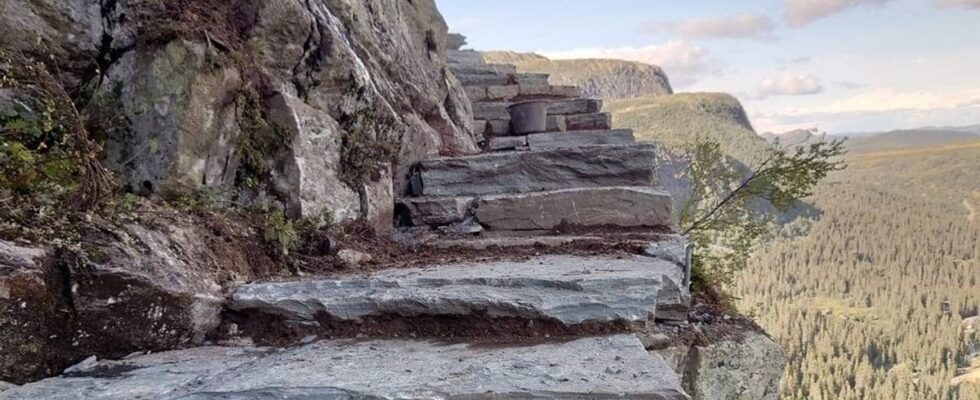Tourism professor at the University of Tromsø, Arvid Viken, believes there have been too many Sherpa stairs. – There will be so many that the stairs themselves are no longer an attraction, he says. Viken is one of many who have noticed that Norway has become obsessed with creating hiking trails with stone steps. – They are everywhere, but they are used and traffic increases significantly almost everywhere with these stairs. No overview or guidelines news told earlier this summer about the many Sherpa stairs that are under construction. No one knows how many Sherpa stairs exist in Norway, or how many are planned. But a count carried out by news shows that in just a few years close to 400 stair paths have been built in the country. In the last two years alone, the Norwegian Environment Agency and NVE have together assessed around 50 applications. There are no overriding requirements that Sherpa stairs must meet. It is the landowner and the individual municipality that decides whether to build such a staircase or not. The Norwegian Environment Agency and NVE provide advice with regard to landslides, drainage, animal protection, parking capacity and nature conservation. – The municipality makes the final assessment. If there is a dispensation, the advantages of the measure must be greater than the disadvantages after an overall assessment, says Ole-Jakob Sande, spatial planner at NVE. Need clear boundaries Storting representative Alfred Bjørlo (V) sees the need for national guidelines, which set clear boundaries for where Sherpa stairs can and cannot be built and how extensive the construction work must be. – It is basically positive that facilities are being made for outdoor life and mountain life, but it should not be the case that it is built everywhere in our mountain home, says Storting representative Alfred Bjørlo (V). Photo: Annika Byrde / NTB He will take it up with Climate and Environment Minister Andreas Bjelland Eriksen (Ap). – When we see that this continues to take off as much as it does, and it almost becomes a kind of fashion wave, I think it is a good idea to have national guidelines, says Bjørlo. The left-wing politician believes that a balance must be found between making arrangements for people to travel in nature and at the same time preserving untouched nature. – If it is to be the case that the norm is that there must be a staircase for people to go up the mountain, we are a bit out of sorts. The aim should not be to have man-made structures everywhere in the wilderness, and that every mountain should have a Sherpa staircase, he says. Do you think there are too many Sherpa stairs? Yes! It’s better with normal paths anyway. No. I think it’s nice to have prepared paths. I think it’s fine with both parts. I don’t care Show result Fears destruction Some Sherpa stairs involve significant interventions in nature. In some places, local stone is not used either, but is transported in by helicopter. Senior adviser at the protected areas section in the Norwegian Environment Agency, Hege Husby Talsnes, therefore believes that the municipalities must think carefully. – Prepared stone stairs can help preserve natural areas, by channeling traffic and minimizing damage to vulnerable areas. They can also make paths more resistant to climate change, says Torgeir Nergaard Berg in DNT. Photo: Den Norske Turistforening (DNT) – It is essential that the arrangements are proportionate to the need, and that no more arrangements are made than are necessary. Excessive planning can lead to unnecessary destruction of nature, she says. At the same time, larger crowds create a need for organized parking, possibly food service and accommodation, says Torgeir Nergaard Berg, adviser for cabin and route work in DNT. – It can also have a negative effect on wildlife, and tempt inexperienced people high into the mountains, he says. The Nature Conservancy: – Take it easy A survey conducted by Odd Lennart Vikene and Jostein Rønning Sanderud among 22 hikers in Northwest Norway shows that there are also mixed feelings about the Sherpa stairs among the hikers. Several point out that less muddy and more comfortable paths provide a better hiking experience. Others tell of a more monotonous and strenuous experience. Leader of the Norwegian Nature Conservation Association, Truls Gulowsen, believes that the Sherpa steppes are beginning to approach a saturation point. The stairs must be built where wildlife and nature tolerate it. – We must learn from the advantages and disadvantages of the stairs that have already been built. We should take it a bit easy, especially after the severe “stair commotion” we have seen in recent years, says Gulowsen. Truls Gulowsen is not against all arrangements, but believes that future Sherpa stairs should gain experience from established ones. Photo: Eivind Molde Published 13.08.2024, at 17.02
ttn-69
Sherpa stairs are appearing all over the country – but no one has an overview of where and how – news Vestland

